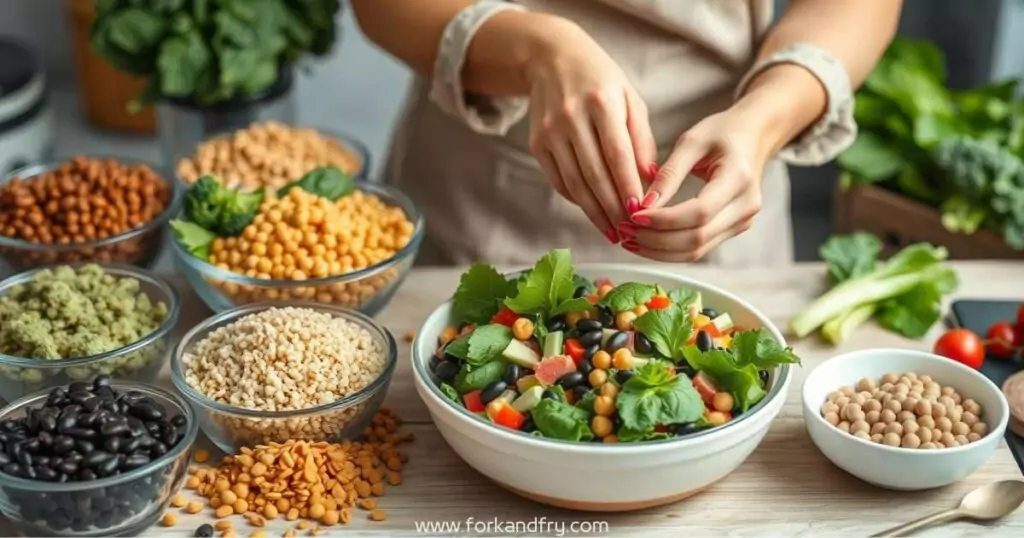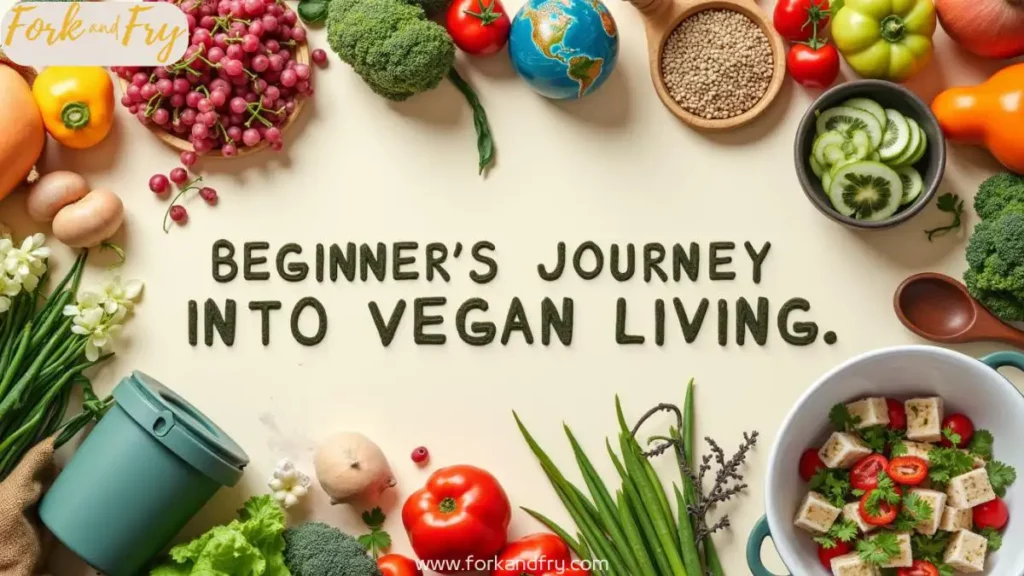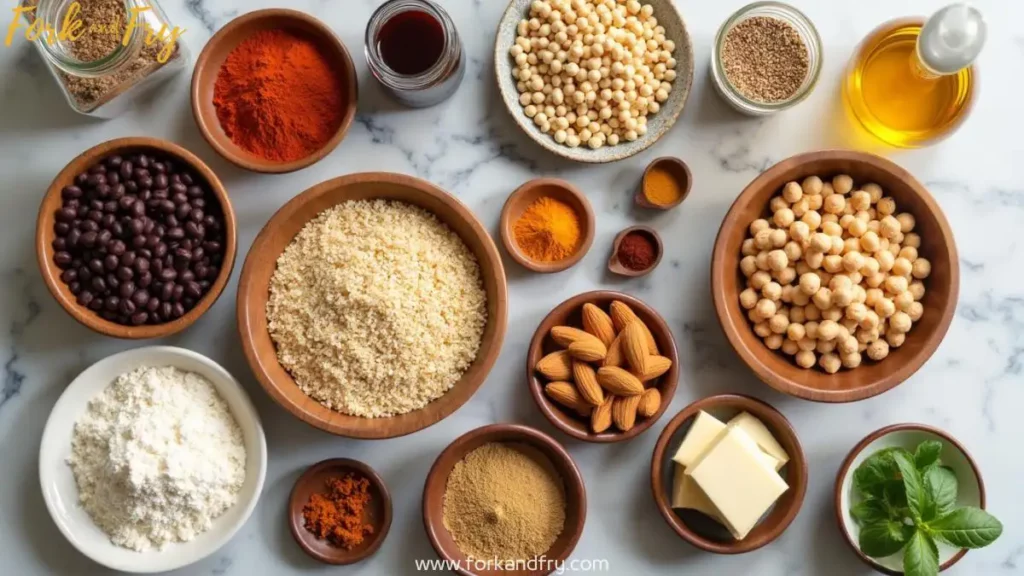Last updated on February 17th, 2025 at 09:35 pm
Table of Contents
As a vegan, I’ve seen the amazing changes a plant-based lifestyle can bring. Switching to a vegan diet six years ago boosted my energy and digestion. It also gave me a new sense of purpose. But, I had to find ways to get enough protein without animal products.
That’s why I’m thrilled to share a detailed high-protein vegan diet plan. It’s not just tasty; it’s also good for your body and helps you reach your health goals.


Key Takeaways
- Vegan diet can provide ample protein from plant-based sources like legumes, nuts, and seeds.
- A high-protein vegan diet can support weight management and muscle building.
- Incorporating a variety of protein-rich foods ensures you meet your daily needs.
- Meal planning and preparation are key to maintaining a balanced, high-protein vegan diet.
- Consulting a registered dietitian can help address any nutrient deficiencies on a vegan diet.
Understanding Plant-Based Protein Sources
Plant-based proteins offer many options for those who don’t eat meat. You can find high-protein foods like tofu, tempeh, seitan, and nutritional yeast. Knowing the difference between complete and incomplete proteins is important for a vegan diet.
Complete vs. Incomplete Proteins
Complete proteins have all the amino acids we need. Foods like soy products, seitan, tempeh, and nutritional yeast are complete. Grains, nuts, and most veggies are incomplete, so you need to pair them to get all amino acids.
Daily Protein Requirements for Vegans
The U.S. says we need 0.8 grams of protein per kilogram of body weight. The World Health Organization suggests 0.66 grams. For a 140-pound person, 50 grams of protein is 10 percent of daily calories.
Studies show vegetarians and vegans get 70 percent more protein than needed. Non-vegetarians eat almost 80 grams on average.
Essential Amino Acids in Plant Foods
Some plant foods, like quinoa and soy, are complete proteins. Others might lack certain amino acids. By mixing foods like beans and rice, you get all amino acids your body needs.
Plant-based diets often have 12 to 15 percent of calories from protein. This is more than enough for most people.


“Most whole-food, plant-based diets provide a protein content of 12 to 15 percent of total calories or higher, meeting protein needs even for athletes.”
Benefits of a High-Protein Vegan Diet
Switching to a high-protein vegan diet offers many health and environmental perks. It helps you manage your weight, build muscle, and lower your carbon footprint. This is all thanks to eating more plant-based, protein-rich foods.
Weight Management and Muscle Building
A high-protein vegan diet is great for keeping your weight in check. It combines filling, fiber-rich plants with top-notch vegan proteins. This combo keeps you full longer, reducing cravings and helping you avoid overeating. Plus, it supports muscle growth and recovery, keeping you toned and healthy.
Environmental Impact
Choosing a high-protein vegan diet is also good for the planet. Animal farming is a big source of pollution, uses a lot of land and water, and leads to deforestation. By opting for plant-based proteins, you cut down your carbon footprint and support eco-friendly farming.
Health Advantages
A well-thought-out high-protein vegan diet is packed with health benefits. It’s been linked to lower risks of heart disease, type 2 diabetes, and some cancers. The high fiber in plant foods also boosts your digestive health and overall well-being.


“Switching to a high-protein vegan diet can greatly benefit the environment. Animal agriculture is a leading cause of greenhouse gas emissions, extensive land and water use, and deforestation.”
Adding high protein vegan meals and vegetarian meal prep recipes to your life can bring many benefits. Whether you’re looking to lose weight, build muscle, or just feel better, a high-protein vegan diet can help. It’s a win-win for you and the planet.
Top Vegan Protein-Rich Foods
Adding different plant-based proteins to your diet is essential for a healthy vegan lifestyle. From legumes to greens, vegan protein options are vast and tasty. Let’s look at some top vegan protein-rich foods to enhance your plant-based meals.
Legumes like beans, lentils, and chickpeas are packed with protein. One cup of cooked beans has up to 15 grams of protein. Lentils offer 18 grams per cup. Tofu and tempeh, made from soybeans, have 20 and 34 grams of protein per cup, respectively.
Nutrient-dense greens such as spinach add 5 grams of protein per cup. Edamame has 17 grams per cup. Whole grains like quinoa and wild rice also provide protein, with 8 and 7 grams per cooked cup.
Nuts and nut butters are great for a protein boost. Almonds give 7.5 grams of protein per quarter-cup. Peanut butter offers 8 grams per 2 tablespoons.
By using these vegan protein powerhouses in your recipes, you can make tasty, nutritious meals. These meals will keep you energized and satisfied all day.
| Food | Protein (per serving) |
|---|---|
| Tempeh | 17 g per 1/2 cup |
| Edamame (shelled) | 9 g per 1/2 cup |
| Tofu | 7 g per 3 ounces |
| Soy milk | 7 g per 1 cup |
| Nutritional yeast | 3 g per 2 tablespoons |
| Seitan | 21 g per 3-ounce serving |
| Quinoa | 8 g per 1 cup |
| Wild rice | 7 g per 1 cup |
| Oats | 5 g per 1 cup |
| Buckwheat | 6 g per 1 cup |
| Green peas | 4 g per 1/2 cup |
| Spinach | 5 g per 1 cup |
| Brussels sprouts | 2 g per 1/2 cup |
| Sprouted grain bread | 3-6 g per slice |
| Russet potato | 8 g per large potato |
| Red potato | 7 g per large potato |
| Sweet potato | 2.5 g per medium potato |
| Lentils | 18 g per 1 cup |
| Chickpeas | 15 g per 1 cup |
| Black beans | 15 g per 1 cup |
| Pumpkin seeds | 9 g per 1 oz |
| Hemp seeds | 9 g per 3 tablespoons |
| Tahini | 6 g per 2 tablespoons |
| Almonds | 9 g per 1.5 oz |
| Walnuts | 7 g per 1.5 oz |
| Cashews | 8 g per 1.5 oz |
| Peanut butter | 8 g per 2 tablespoons |


By adding these diverse plant-based proteins to your diet, you meet your daily protein needs. You also enjoy a wide variety of delicious and nutritious vegan protein recipes.
Vegan Diet Plan High Protein: 7-Day Meal Plan
Starting a high-protein vegan diet doesn’t mean you have to give up taste or variety. Our 7-day meal plan is full of tasty breakfast, lunch, and dinner options. They’re all packed with plant-based protein and super satisfying.
Breakfast Options
Begin your day with these protein-rich breakfasts:
- Vegan Freezer Breakfast Burritos: These burritos are filled with tofu, beans, and veggies. They’re easy to grab and go.
- Blueberry Almond Chia Pudding: This pudding is creamy, has juicy blueberries, and crunchy almonds. It’s a great way to start your day.
- Savory Oatmeal with Roasted Veggies: Warm oats, roasted veggies, and toasted pumpkin seeds make for a delicious breakfast.
Lunch Suggestions
Boost your afternoon with these protein-rich lunches:
- Vegan Kale Caesar Salad with Tofu Croutons: This salad is a twist on the classic. It has crisp kale, creamy cashew dressing, and crunchy tofu croutons.
- Lentil and Sweet Potato Burrito Bowl: This bowl is filled with lentils, roasted sweet potatoes, avocado, and vegan sour cream. It’s a filling and healthy meal.
- Quinoa and Edamame Salad with Pesto: This salad combines fluffy quinoa, protein-rich edamame, and a vibrant pesto dressing. It’s fresh and flavorful.
Dinner Recipes
Finish your day with these tasty and protein-rich dinners:
- Curried Sweet Potato & Peanut Soup: This soup is creamy and spicy. It features sweet potatoes and peanut butter.
- Tofu Stir-Fry with Broccoli and Cashews: This stir-fry has crispy tofu, crunchy broccoli, and roasted cashews. It’s quick and nutritious.
- Chickpea and Vegetable Tagine: This Moroccan stew has chickpeas, veggies, and aromatic spices. It’s served over basmati rice.
This 7-day meal plan is packed with at least 80 grams of protein and 30 grams of fiber each day. It meets or exceeds daily values. With a mix of plant-based proteins, it’s a tasty and healthy way to support your health and fitness goals.


Legumes and Pulses in Vegan Nutrition
Legumes and pulses are key in a high-protein vegan diet. They are not just high in protein but also add to the nutritional value of your meals. Chickpeas, lentils, beans, and peas are packed with benefits for a vegan lifestyle.
Chickpeas, or garbanzo beans, have about 15 grams of protein per cooked cup. They taste nutty and are great in salads, soups, or as a snack. Lentils, with 18 grams of protein per cooked cup, are perfect for stews and curries.
- Chickpeas: 15 grams of protein per cooked cup
- Lentils: 18 grams of protein per cooked cup
- Black beans: 15 grams of protein per cooked cup
- Green peas: 8 grams of protein per cooked cup
Legumes and pulses are incredibly versatile. They fit well in salads, soups, stews, and dips. They’re not just a good protein source but also rich in fiber, vitamins, and minerals.
“Legumes and pulses are the cornerstone of a high-protein vegan diet. They offer a delicious and sustainable way to meet your protein needs while supporting your overall health.”
Adding legumes and pulses to your vegan meals is a great way to nourish your body. They help with muscle building, weight management, and provide a balanced diet. These plant-based foods should be a must-have in your vegan kitchen.


Plant-Based Protein Supplements
For vegans, getting enough protein can be tough. But, plant-based protein supplements can help a lot. They make sure you get the protein you need for muscles, weight, and health.
Protein Powders
Protein powders from plants like pea, hemp, and rice are great for vegans. You can mix them into smoothies, shakes, and even some foods. This boosts the protein in your meals. Choose powders with all amino acids for the best nutrition.
Natural Protein Boosters
There are also natural ways to add protein to your diet. Nutritional yeast has about 8 grams of protein per 2-tablespoon serving. Spirulina, a blue-green algae, has about 4 grams per tablespoon. Chia seeds and hemp seeds offer 5 and 10 grams per 2-tablespoon serving, respectively.
Adding these vegan protein sources to your diet can help meet your protein needs. This supports your health and well-being on a vegan diet.
“As a vegan, getting enough protein can be a concern, but with the right supplements and a balanced diet, it’s definitely achievable.”
Meal Prep Tips for High-Protein Vegan Meals
Keeping a high-protein vegan diet needs good meal planning and prep. Meal prepping helps you hit your protein goals and enjoy tasty, healthy meals all week. Here are some easy tips for vegan meal prep to boost your protein intake.
Batch Cooking for Efficiency
Batch cooking is key for vegan meal prep. Cook big batches of protein-rich foods like legumes, grains, and tofu. For instance, cook quinoa or brown rice early in the week for different meals. Roast extra-firm tofu to add to stir-fries, sandwiches, and salads. This saves time and keeps you stocked with healthy ingredients.
Make-Ahead Protein-Packed Snacks
Having protein-rich vegan snacks ready is also crucial. Try making edamame mash or smashed edamame toast for the week. Edamame mash has about 18-20 grams of protein per serving. Smashed edamame toast has a whopping 31 grams per serving.
Plan Meals for the Week
Plan your meals for the week to make meal prep easier. Create a menu with breakfast, lunch, and dinner ideas. For example, an Asian-inspired almond butter tofu noodles dish has 37 grams of protein per serving. Planning ahead helps you have all ingredients ready and avoids last-minute rushes.
By using these vegan meal planning and batch cooking tips, you can easily follow a high-protein vegan diet. Spending a little time preparing healthy, protein-rich meals and snacks will benefit you all week. It keeps you energized and helps you reach your health and fitness goals.
Common Challenges and Solutions
The rise in vegan nutrition is clear, with a 500% increase in vegan numbers in the U.S. from 2014 to 2017. Vegans face two big challenges: getting enough protein and avoiding nutrient deficiencies.
Meeting Protein Goals
Reaching protein goals on a vegan diet can be challenging, as plant-based proteins often lack certain essential amino acids. To fix this, vegans need to mix different protein sources. This means pairing legumes with grains or adding nuts, seeds, and soy-based foods to meals.
Avoiding Nutrient Deficiencies
Vegans often worry about not getting enough vitamins B12, iron, and zinc. Eating fortified foods like plant-based milks and cereals helps. Some might also need supplements to get all the nutrients they need.
Planning meals and learning about plant-based nutrition helps vegans meet their nutritional needs. Getting advice from a registered dietitian can also be very helpful. They can create a vegan diet plan that’s high in protein.
“Transitioning to a vegan diet requires thoughtful planning to ensure you’re meeting all your nutritional needs. With the right strategies, it’s completely possible to thrive on a high-protein, plant-based diet.”
Combining Protein Sources for Maximum Benefits
To get enough protein in a vegan diet, you need to mix different plant-based foods. Foods like edamame, tempeh, quinoa, and buckwheat are good sources. But, mixing them helps your body get all the amino acids it needs.
Pairing foods like grains and legumes is key. For instance, black beans with rice or whole wheat bread with peanut butter gives your body all amino acids. This method, called protein complementation, boosts the nutritional value of vegan diets.
You can also add variety to your protein intake. Try a salad with quinoa, edamame, and hemp seeds, or a stir-fry with tempeh, broccoli, and brown rice. This way, your body gets all the nutrients it needs to stay healthy.
FAQ
What are the benefits of a high-protein vegan diet?
A high-protein vegan diet can help with weight management and muscle building. It also benefits the environment and may reduce the risk of heart disease, type 2 diabetes, and other health conditions.
What are the top vegan protein-rich foods?
Top vegan protein-rich foods include beans, lentils, tofu, and edamame. Spinach, quinoa, tempeh, and seitan are also great options. Nuts and nut butter provide protein and extra nutrients and fiber.
What does the 7-day high-protein vegan meal plan include?
The 7-day meal plan offers a variety of breakfasts, like Vegan Freezer Breakfast Burritos and Blueberry Almond Chia Pudding. Lunches include Vegan Kale Caesar Salad with Tofu Croutons. Dinners feature dishes like Curried Sweet Potato & Peanut Soup.
How can legumes and pulses contribute to a vegan diet?
Legumes and pulses are crucial for vegan nutrition. They offer high protein and fiber. For example, chickpeas have about 15 grams of protein per cup. Lentils have 18 grams. They’re versatile and boost the nutritional value of vegan meals.
What are some plant-based protein supplements for vegans?
Plant-based protein supplements include protein powders from pea, hemp, or rice. Natural boosters like nutritional yeast, spirulina, and chia seeds can also increase protein intake. These can be added to meals and snacks.
What are some common challenges in a high-protein vegan diet, and how can they be overcome?
Challenges include meeting daily protein goals and avoiding nutrient deficiencies. Diversify protein sources and combine different plant proteins. Consider fortified foods or supplements for B12, iron, and zinc. Regular meal planning and learning about plant-based nutrition can help.
How can combining different protein sources benefit a vegan diet?
Combining various protein sources helps achieve a complete amino acid profile. For example, pairing legumes with whole grains or nuts with seeds creates complete proteins. This approach maximizes the nutritional benefits of plant-based proteins.





